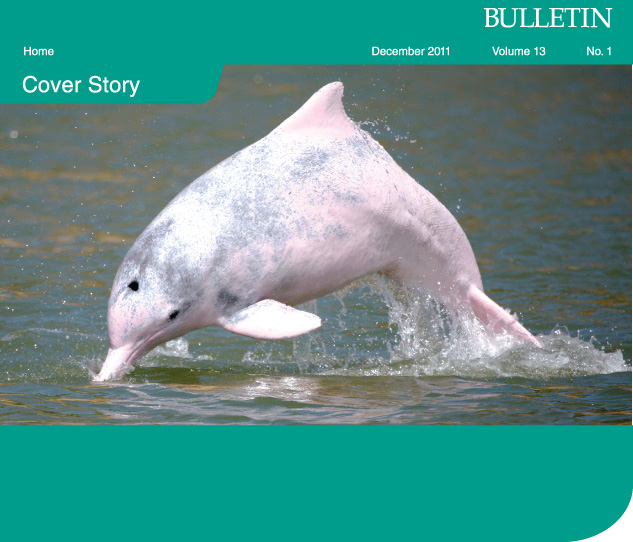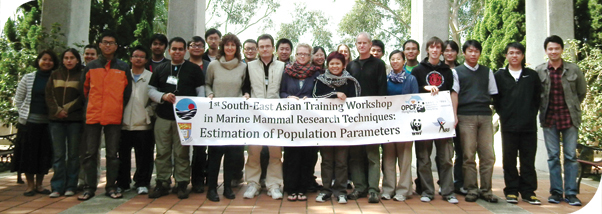
|
|
Dr Leszek Karczmarski joined HKU's Swire Institute of Marine Science (SWIMS) in August 2009 to set up a research program into cetacean ecology and conservation. He is currently helming a research project investigating ecology, population structure and socio-behavioural dynamics of Chinese White Dolphins (Sousa chinensis) across the Pearl River Estuary. Studies of Chinese White Dolphins (CWD), or Indo-Pacific Humpback Dolphins, as they are known in scientific literature, have been limited, partly because it is such an elusive species and not easy to investigate with traditional observational techniques. Dr Karczmarski and his team conduct their research by tracking them from the shore using sophisticated optical instruments and photographing them from boats using high-speed cameras. They identify individual group members to investigate the behavioural processes that determine their day-to-day life and that ultimately shape the structure of the entire population. He has set up a field station in Tai O, partly funded by Ocean Park Conservation Foundation (OPCF) and partly by an RGC grant, which he and his team use as a base for their voyages in search of the CWD. Individual dolphins are identified by unique features such as notches and dark dots on their dorsal fins and upper bodies. Another challenge to research is the behavioural complexity of the CWD. Says Dr Karczmarski, "with these sophisticated mammals you're not just looking at the basic survival instincts of food, shelter, mate; you're looking at an interwoven and intelligent society." Dolphins cannot survive without their social environment – particularly off-shore, where a single dolphin often means a dead dolphin. Cooperation is key to their survival. Conservation ecology "Their way of life determines the viability of their population and their future," says Dr Karczmarski. "Jointly with a Taiwanese colleague, Dr Huang Shiang-lin, and researchers from Zhuhai, we have determined that the current conservation status of CWD in the Pearl River Estuary is far worse than previously thought." They estimate that the population is declining by 2.45 per cent annually; if this rate of decline remains constant, about 76 per cent of the current population will be lost in the lifespan of three generations, which is less than 60 years. "This should be a very serious concern," he says. "Clearly, the current management practices do not provide a meaningful tool for conservation. Our estimates suggest that having this declining trend detected by periodical surveys as currently conducted by Hong Kong authorities, would take one to three generations (depending on the CV of abundance estimate) by which time a substantial part of the population might have already been lost." "Most evidently, revision of the current management strategy is urgently needed, both in Hong Kong and Mainland China. Dr Huang, who is a collaborator and was a senior author on this project will soon join us as post-doc at SWIMS to jointly take this research further." Establishing regional hub Collaboration is vital to comparative studies and Dr Karczmarski's long-term goal is for Hong Kong to become a regional hub for marine mammal research. "It was the idea of establishing a regional hub for research of an international significance that attracted me to Hong Kong in the first place," he says. "The Asia-Pacific Cetacean Research Centre would be an initiative that could instigate and integrate research and marine mammal conservation in this little known bio-region." "If you look at Southeast Asia, outside of New Zealand, Australia and Japan, there is very little in a form of comprehensive cetacean research; there are several small projects out there, but most of them are relatively basic. Yet the region has enormous potential. It's both challenging and fascinating." Dr Karczmarski already has a well-established collaboration with Sun Yat Sen University in Zhuhai and National Taiwan University in Taipei, in both of which he co-supervises postgraduate students. "We are building one coherent dataset that stretches across the Pearl River Estuary and beyond,"he says. "The involvement of Ocean Park Conservation Foundation was particularly helpful in facilitating this valuable initiative." He is now looking to set up links with established institutions in Japan, Australia and New Zealand and then integrate local players in Southeast Asia such as in Thailand, Malaysia, Indonesia and western Pacific island states. The process has already begun with the launch of a series of workshops, partly funded by OPCF, aimed at promoting and standardizing quantitative research techniques across Southeast Asia. The first was a networking event in mid-2010 set up jointly with Professor Zhou Kaiya from Nanjing Normal University and there have been two research workshops in Hong Kong since. "At the moment standards of expertise vary and research techniques are too disparate," says Dr Karczmarski. "I hope to standardize techniques, so that we are all talking the same language in terms of science. This will facilitate networking and knowledge exchange." HKU has high expertise in this area and some of his postgraduate students conduct their research in exotic distant locations such as Costa Rica, Egypt and South Africa. "By the time HKU students graduate they will already have established a professional global network which will be invaluable to their future research career and will make comparative ecological research easier and more effective," he says.
|
| Back | Next | |
